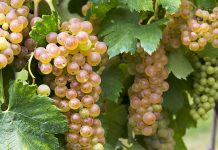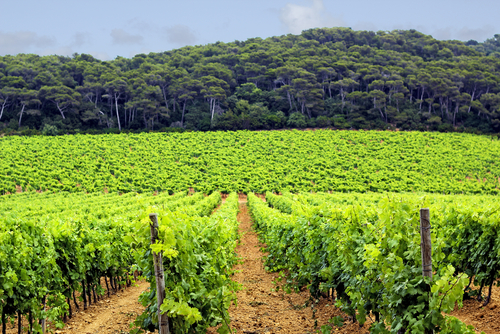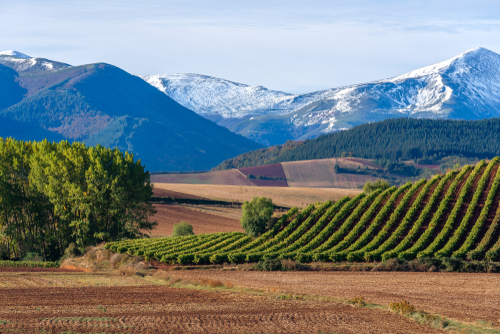If you are offered to taste orange wine, what do you think you will see in your glass? A wine made from orange juice or other fruit that can give it this color? Well, this type of wine is made from grapes, and from white grapes. Vinified according to a very old method, originating from antiquity, this wine is back in fashion these last years. Let’s discover together the secrets of this wine with a very particular vinification.
Orange wine : the origins
Unlike blue wine (whose color comes from dyes), orange wine gets its color from its unique manufacturing process. This wine has been brought up to date since the 2000s with the revival of natural wines. However, orange wine has been made for much longer than that and finds its origins in antiquity. Indeed it is a very old winemaking method which is used to make this wine with the disconcerting color. Dating back about 8000 years, it originates from the Caucasus and more precisely from Georgia. In this country, it is also called “amber wine“. At that time, it is in the region of Kakhetia that the population produced this wine. They fermented the whole bunches of white grapes (i.e. not destemmed) in sealed and buried amphorae, called kvevri. This fermentation could last several months.
As for the name “orange wine”, it comes from David A. Harvey of Raeburn Fine Wines, a British wine importer, who marketed this amber wine from 2004. It is obvious that this wine vinified according to this particular method takes its name from its final orange color.
The manufacture of orange wine
Orange wine, a white wine from maceration
Orange wine, also called “white from maceration”, is a wine made from white grapes, vinified in the same way as red wine.
Usually, to produce white wine, white grape varieties are pressed directly after the harvest and then the must (grape juice) is extracted to be vinified. In the case of orange wine, as with red wines, the grapes are crushed and the juice is left in contact with the marc (or pomace) for a certain period of time. The marc is made up of the skin, the seeds and sometimes the stalks. This method is called skin contact maceration. It is used for red, rosé and white wines.
Although this wine is considered a white wine, orange wine is sometimes categorized as the 4th color of wine.
What is the purpose of this pellicular maceration?
The grapes, to produce a colored and structured wine, need to go through maceration. This step allows to pigment the juice and to make it gain in character. The color is contained in the grape skin thanks to polyphenols and anthocyanins, natural pigments.
Like the color, the structure is also present in the skin but also in the stalks and seeds, in the form of tannins. Thus, by letting the juice macerate with the pomace for a few days or even months, the pigments and tannins infuse the grape juice. In the same way as for black grapes, tannins, polyphenols and anthocyanins are contained in the skin of white grapes. The orange wine being a white wine of maceration, it is thus colored and tannic what makes it more digestible and with a lower alcohol content than the other white wines.
The pellicular maceration requires that the grapes are harvested at perfect maturity. Leaving the juice in contact with the skins, seeds and stalks not only colors and structures the wine, but also extracts the good and bad aromas. Thus, the grapes must be in good condition and have reached a perfect phenolic maturity. If not, the pomace can give the wine harsh or “green” aromas.
A winemaking technique, not an appellation
Orange wine is not an appellation. It can be produced anywhere in the world and in all wine regions. It designates a winemaking technique, so there is no rule about the territory of production. Similarly, there is no rule on the type of grape variety to be used (they must simply be white).
This winemaking technique, after being born in Georgia, has spread to Slovenia and northern Italy. In the 90’s, two northern Italian winemakers working with natural wines reused this technique, which had been put aside until then. In Italian, the wines produced are called “ramato“, meaning “copper wine”, or “macerato“, meaning “macerated wine”. These wines are made from grape varieties such as ribolla gialla, malvasia, friulano and pinot grigio. Through this Italian revival, the vinification of orange wine develops. It crosses the borders to settle almost everywhere in the world and especially in France. Many other grape varieties are used to make orange wine. The main ones are Kisi (Georgian grape variety), Gewurztraminer, Chardonnay and Muscat.
Orange wine in France and in the world
As we have seen, after the Caucasus region and Georgia, orange wine was exported to northern Italy. Only then did French winegrowers begin to produce skin contact maceration white wines.
Today, the region of Firoul-Venezia Giulia, in northern Italy, is one of the major producers of orange wine. But it is possible to find it in Croatia, Slovakia, Bulgaria, the United States, New Zealand, South Africa, Australia, Austria, Germany, Switzerland, Spain, Portugal and of course France. In terms of quantity, France is the 2nd European country to produce the most orange wine after Italy.
In France, the production of orange wine remains low compared to other categories of wines. Most of the winegrowers who produce it have adopted organic or biodynamic agriculture or even produce only natural wines. The region where orange wines are most produced is Alsace, followed by Languedoc-Roussillon, but they are also found in the Loire, Jura, Savoie and Rhône Valley.
Winegrowers producing orange wine sometimes continue to opt for the traditional terracotta amphorae, but for practicality, oak barrels and stainless steel vats are also used. The use of the amphora is not specific to the production of orange wine but rather to Georgian traditions.
Orange wine, a natural wine ?
Orange wine is not necessarily a natural wine. As a reminder, natural wines are made from organically grown or biodynamic grapes and are vinified without any added inputs.
Although it has been produced for thousands of years, in France, orange wine is more of an experiment than a tradition. It can be difficult to fit an orange wine into the sometimes very strict rules and specifications of our appellations. Thus, it is easier to find this type of wine with winemakers or neo-winemakers ready to break the codes. It is also more common to find natural orange wines than natural white wines because of the presence of tannins. Tannins, in addition to bringing structure, bring protection to the wine with their antiseptic and antioxidant properties.
The characteristics
Orange wine gives, most of the time, quite structured wines, with aromas of candied fruits and spices. They are wines with character, and a wide and varied aromatic expression. These are wines with powerful flavors, persistent in the nose and mouth. They express themselves through floral aromas (lime blossom), citrus fruits, crushed apples, raisins, nuts, spices, teas, honey and mineral notes, herbaceous, roasted (coffee, toast) or oxidation.
The characteristics of the wine can vary considerably depending on the grape varieties used. The terroir, the partial or total destemming of the grapes, the duration of maceration, the type of aging, the voluntary oxidation and certain other factors (wine-making container, age of the wine, etc.) can also change the final result and the taste of the orange wine.
Orange wines are, most of the time, more digestible, aromatic and less acidic than the classic white wines. Being quite dry, the taste of alcohol is very low, but these wines remain quite fresh and complex.
How to taste orange wine
Orange wines are quite complex, sometimes difficult to identify. The amateurs will be surprised, while the professionals will know how to detect their qualities and their so particular tastes. Orange wines are sometimes confused with oxidized, maderized or sweet wines. This confusion comes from the color of the dress which is similar. They are however very different wines.
Moreover, orange wines have a good ageing potential, because of their tannic side.
Aeration is highly recommended
Orange wine, even more so if it is natural, can present some particular aromas when the bottle is opened. These aromas are sometimes not very pleasant (stale or stables smells ). If the grapes were harvested a little too early, the tannins can be hard and the wine can express harsh flavors in the mouth. Similarly, with little or no added input, the presence of gas following fermentation can lead to a slight effervescence. The wine is then “sparkling”. It is therefore almost systematically recommended to aerate them before drinking. Aerate these wines for a few hours will allow the aromas to open up and become more pleasant. The effervescence will fade and the tannins will soften. The wine will then reveal its full potential and your experience will be all the more enjoyable. And of course, you can use the Aveine aerator for this step!
What to pair orange wine with?
In terms of food and wine pairing, their tannic structure allows them to accompany an entire meal, from appetizer to dessert. They are also a perfect accompaniment to hard cheeses, and certain dishes with character such as game. Finally, in terms of desserts, orange wine goes perfectly with chocolate, because chocolate enhances the tannins of the wine.
Orange wine : our top 5 !
If you want to take the plunge but don’t know where to start, here is a selection of 5 orange wines to discover!
Riesling & Sylvaner – We are free – Maison Moritz-Prado
This orange wine is composed of 50% Riesling and 50% Sylvaner. Without added sulfite and unfiltered, it is aged in amphora for 11 months. The skin contact maceration gives this wine silky tannins, aromas of exotic fruits, almonds and spices.
Sous Le Manteau – Orange – Domaine des Amiel
White Grenache and Vermentino make up this orange wine. A skin contact maceration of 3 to 4 weeks followed by an ageing in casks reveal vegetal aromas (lemon balm), citrus fruits and a beautiful minerality.
Meraviglia – Domaine Valentina Passalacqua
Let’s go to Italy with this natural orange wine, IGP Puglia, produced biodynamically and vinified from the Falanghina grape. If the aromatic power given by the pellicular maceration of orange wines scares you, Meraviglia is the ideal wine to start with. This wine is light with only 10 degrees of alcohol and expresses aromas of exotic fruits and citrus.
Qvevri Orange – Tillingham
English wines are also orange wines! This wine is made from four grape varieties, Bacchus, Müller Thurgau, Madeleine Angevine and Ortega. The skin maceration goes from 1 month to 4 months depending on the variety. This wine is light (9 degrees of alcohol), fruity (citrus and stone fruit aromas) and mineral which makes it very easy to drink!
Marina Mtsvane – Iago’s wine
This top 5 would not be complete without an orange wine from Georgia! This amber wine from the Kakhetia region is produced from the Mtsvane grape and is aged in the traditional Kvevri. Citrus aromas are mixed with spicy (nutmeg, ginger) and smoky notes.
Conclusion
Although it is thousands of years old, orange wine remains a novelty for us. This atypical wine breaks the codes of flavors to which our palates are accustomed. The first sips can therefore disconcert more than one! But served in the right conditions of aeration, this amber colored wine is an experience not to be missed!








